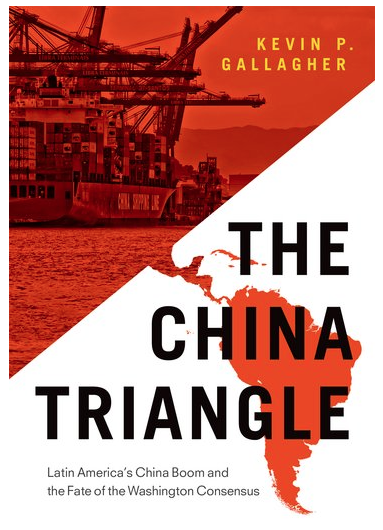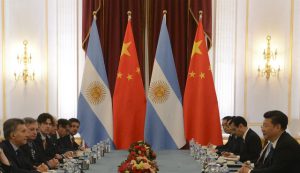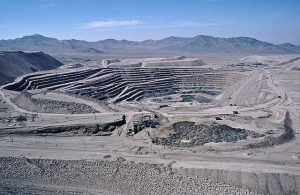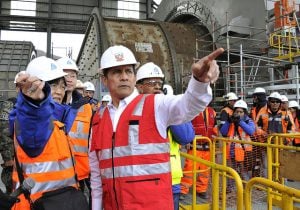Since the turn of the century, Latin America’s fortunes have become intimately entwined with those of China. Latin America possesses an abundant supply of copper, iron ore, soya and crude oil – precisely the products China needed to fuel its explosive growth. Chinese demand fuelled a near decade-long economic boom in the continent.
Now, however, China’s economic readjustment means Latin America is facing a bumpy landing. Commodity prices have slumped to record lows and a decade of policies promoting the export of raw materials in many countries has left the wider region facing multiple political, economic, social and environmental challenges.
China’s strategic interest in Latin America’s resources meant the region’s governments failed to diversify away from commodity exports during the good times or to robustly enforce laws on environmental protection. The ‘China boom’ exacerbated conflicts over resources, pollution and forced displacement at sites such as the Yasuní national park in the Ecuadorean Amazon. There, China’s CNPC and Sinopec recently began drilling for oil after the host government failed to garner international support to keep it in the ground.
 In his new book "The China Triangle: Latin America’s China boom and the fate of the Washington Consensus", Boston University’s Kevin Gallagher argues that the case of Yasuní is emblematic of strategic Chinese investment in Latin America, focused as it is on environmentally degrading sectors. Gallagher also says that while China is portrayed as a ruthless pursuer of raw materials Chinese companies, despite having a weaker regulatory environment at home, often outperform Swiss or American companies in terms of compliance with local laws.
In his new book "The China Triangle: Latin America’s China boom and the fate of the Washington Consensus", Boston University’s Kevin Gallagher argues that the case of Yasuní is emblematic of strategic Chinese investment in Latin America, focused as it is on environmentally degrading sectors. Gallagher also says that while China is portrayed as a ruthless pursuer of raw materials Chinese companies, despite having a weaker regulatory environment at home, often outperform Swiss or American companies in terms of compliance with local laws.
Gallagher spoke to to Diálogo Chino about Latin America’s relationships with the world’s two largest economies, China’s globalisation and why the country is not to blame for Latin America’s environmental problems.
Diálogo Chino: So much has changed over the past 18 months within the China, US and Latin America triangle that you describe in your new book. What has been the most significant event in this period?
Kevin Gallagher: The most significant event has been the shifting global economic context: The slowdown in the Chinese economy and the movement towards rising interest rates in the US. Those two points in the triangle have had the most significant change and has ushered in the new era of China-Latin America relations. It really started in 2013 but the past 18 months have really solidified that. Latin America was growing from 2000-2013 but the engines of that growth: free money from the US during low interest rates and increasing demand from China for commodities, have reversed. For the first time since the 1990s there’s been net negative capital flows to Latin America, meaning more money is going out of the region than going in.
DC: How has this slowing demand in China affected Latin American economies?
KG: From 2003 to 2013 Latin America experienced a commodity boom. While a lot of people were probably reading about the incredible growth miracle that happened during the same period in China, when it entered into the World Trade Organization and got integrated with the world economy, this also created a miracle in places like Africa and Latin America. The copper wire going into the electronics exports came from Chile and Peru, iron and steel for the skyscrapers in the cities came from Brazil and Peru, soybeans for Chinese whose incomes were increasing and who live on a soy-based diet came from Paraguay, Argentina and Brazil. As this demand for China’s great industrialisation made the countries rich, Latin America won the China lottery.
DC: But Latin America has found itself prioritising commodity exports before, while other regions focussed on industry, didn't it?
KG: Indeed. Latin America also won the lottery of the 19th century because during the industrial revolution, Latin America happened to have what the West needed. The West was moving off the farm and away from the mines and into the cities to industrialise, and Latin America supplied the primary commodities for that and grew significantly in the same way. But Latin American countries have not realised how to diversify into other, cleaner sectors and also have failed to think about managing natural resources in a less intensive way that creates less social conflict, while still maintaining the ability to use these resources for economic gain.
DC: In your book you note the increasing awareness of the impacts of China’s trade and investment on the environment in Latin America. There is an argument that because of the high environmental costs at home, China now exports polluting and resource intensive industries overseas. How much credibility do you give that?
KG: Primary commodities are endemically carbon-intensive and highly-polluting. Yes, it’s China that happens to be the place where, at this point, the demand is, but is China exporting its environmental problems? China is just industrialising like the West did and neither the West nor China has come up with a clean and alternative path. On paper, South America and Mexico have higher levels of environmental standards than the Chinese, they are just turning a blind eye to them in order to be able to export stuff to China.
China has really helped the world to reduce carbon emissions by pioneering new technologies and accelerating their diffusion better than we’ve seen in 50 years, but they’re not globalising their big domestic contributions. They’re globalising the things that are on the way out at home. For example, we’re seeing fewer coal plants in China. Latin America is stuck in a commodity-led growth mindset that was only accentuated by Chinese demand. Too much blame is placed on China and it’s too easy for Latin Americans to blame others for their environmental problems. As I say in the book, these economies need to use those as sources of growth to diversify into cleaner and more socially inclusive economic activity. That means protecting natural resources.
DC: To what extent were Obama’s recent visits to Cuba and Argentina motivated by these countries closer relationship with China over the past decade?
KG: Hopefully China’s engagement within Latin America shifts US policy away from taking the region for granted. We gave the region very little attention but when we do give it attention, it’s been very patronising; telling someone how to run an election, telling them how to run their economy with no finance or commitment to back it. The Chinese don’t tell you how to run your economy and they leave a big bag of money behind. The US really needs to create a narrative of ‘partnering’‘ with the Latin Americans, not being patronising towards them. There are a lot of things that brought Obama to Cuba – a lot of domestic politics around it – China is part of the equation but it’s not the whole thing.
A previous version of this article was first published on Diálogo Chino







